The Kuriki method (the first edition in 2007) is a theory about Tourette’s syndrome (tic disorder) and obsessive-compulsive disorder to cure these diseases without medication. This theory is based on the author’s inference and interpretation regarding the structure of these diseases. Since it has been written for the psychoanalysts, reading will be difficult for people in general and it might be sometimes read erroneously. Therefore the Kuriki method must presuppose that the patient is treated by a nearby psychoanalyst, and that, between the patient and the Kuriki method, there is always the psychoanalyst. The explosion of emotional catharsis, which has strong repercussions, is done only for three seconds, once a week: beyond this rhythm, it would be an accident caused by negligence, and the psychoanalyst who is inexperienced in emotional catharsis must take responsibility for the temporary mental collapse caused by the accident. Also, to the patient who has weak capacity of logical reasoning, the psychoanalyst must explain well on the violent emotion of revenge caused by the illusory confusion between the person of the traumatic image in his head and the person in the real world.
Cure for Tourette’s syndrome (tic disorder) and OCD without medication
§07
Nomenclature
On the fundamental error in the question; “Are the figurative terms such as «mass of emotion» scientific?”
While the mechanism of a machine, which has been invented by men, can be described at the level of real objects, the mechanism of something that has not been created by men can be described only with the interpretation of its function as an abstract conception, which has been transformed into an intelligible expression. The description will be simplified with diagrams, images, etc., and, in that way, will be easily understandable.
For example, the calculation of electric current in electric circuits is often described as water flow, and nobody refutes saying electricity is not water.
In chemistry, molecules are represented by Lewis structures with the idea of the stability of eight electrons, while, of course, the real structures of the molecules cannot be drawn on a paper. It is a conceptual way to understand the chemical formulas.
In psychoanalysis, the psychic functions are described with figurative representations. The psychic functions are often represented as things, or the parts of a mechanism: naturally, human mind is not a machine and everybody knows that human mind doesn’t consist schematically of geared functions. Few people understand that psychoanalysis is a theory only to treat neurosis. For the descriptions of psychoanalytic theories, preoccupations other than that of the utility for understanding of the treatment are not necessary. People who are not related to the treatment of neurosis do not understand that the psychoanalytic terms are words that do not make sense to them.
They, who do not know neurosis, do not know that “Unconscious” “Libido” “Super-ego”, etc., are meaningless in a healthy mind. They generalize these words for human beings in general, and do not know the distinction between psychoanalysis and psychology. People who lack scientific knowledge do not know that scientific theories are explained by figurative expressions. For example, they do not know that the continuity of graphs for calculus is only a tool by figurative expression. A graphic continuous curve, which looks like a string, does not exist in the world of numbers, and it is only a practical tool for calculation. The acceptance of the strange way of descriptive expressions is sometimes difficult.
These psychoanalytic elements are not pathogenetic causes of neurosis. The psychoanalytic terms are not as ; “since there is the Unconscious, therefore…”, “since there is the Libido, therefore…”, “since there is the Super-Ego, therefore…”, but only descriptive representations of pathological behavior in a neurotic mind. For the treatment of neurosis, the schematic supposition of the Unconscious facilitates the explanation. It is absurd to say “Freud discovered the Unconscious” : as absurd as “Georg Simon Ohm has discovered that the electric current is water in pipes”, “Leibniz discovered dx of derivative under his microscope”, etc.
For example, suppose that you buy lottery tickets, of which the probability is 1/10 000 000. Children might think that buying five tickets, the probability will be 5 times higher. But this idea is not very mathematical. In mathematics, 1/10 000 000 can be regarded as zero, and five times zero will still be zero. This is a very fundamental conception in mathematics from high school. “If you bought 5 000 000 tickets, would the probability be 1/2 ?”: this question is not the point of the argument. Very mathematical ideas may seem wrong in children’s arithmetic. The mathematical idea of the convergence to zero is visually recognized by graphic image, since the human being cannot recognize perceptually as a number the logarithmic change of the quantity of something.
¤1earth_elephants
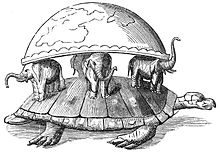
For example, the ancient image of the Earth on a giant turtle and four giant elephants can be seen as the representation of a very scientific concept, but probably children think that this image is only the product of a stupid imagination. While these elephants can be space as an abstract concept, and this turtle, time as an abstract concept, and naturally this image waits for some questions, such as “Where does this turtle swim?”, “Space and time, are they only concepts in the human head, in the mode of our perception?”, etc., if children say that there is no big elephant nor big turtle like that, it is only a kind of childish refutation from the poverty of abstract thinking. There can be small children who really think like : “Ancient men were stupid and they believed that there were four huge elephants and a huge turtle under the earth.” These children do not think about the conception that may be represented. They cannot watch the representation as an interpretative representation, and they consider it as the product of a stupid non-scientific imagination that the ancient men would have believed. It is a pity that there are people who read psychoanalytic descriptions wrongly such like ; “Freud discovered the existence of the Unconscious”, “Psychoanalysis is to believe in the existence of the Unconscious”, etc.
| ¤2desert
|
Understanding abstract conceptions in a concrete way.
On the one hand, to descriptions such as “there is a «mass of emotion» in the Unconscious”, it is difficult to understand that easy oppositions can be infantile oppositions. To say that Freud was stupid and believed the Unconscious existed in the human mind, it is just like to say that electricians are stupid and believe that electric current is a current of water. On the other hand, everyone knows that psychoanalysis cannot be demonstratively scientific, as the Unconscious cannot be observed under a microscope. For the sole purpose of understanding the treatment of neurosis, it is important to understand schematically the domain, which the word “existence of the Unconscious” descriptively represents with mental functions or mental tendencies. Considering a little further the Unconscious as if it were an invisible animal that would be staying «somewhere else», the understanding will be more therapeutic. That is to think these abstract concepts with concrete imagination. Just like you calculate electric current as considering it as water. Also, the neurotic persons who do not know the concept of this pathological structure, which is described by the word “Unconscious”, can be said slaves of the function repressive. Anyhow, Freudian words, such as “Unconscious”, “Libido”, “Œdipus complex”, etc., are terms of psychoanalysis, and they have a meaning only in the treatment for the bodily symptoms of neurosis.
(«Somewhere else» means inference is impossible.)
Nomenclature
Freud could not cure tic disorders. The theory of the Kuriki method is quite different from the psychoanalysis of Freud, and the readers will have confusions in the definitions of the terms. As the Kuriki Method is a small theory, the list of all the terms that might cause confusion can be presented. The Kuriki Method is a reasoning that aims the structure of tic disorder and Obsessive-Compulsive Disorder, on the premise of the strong function of the bodily repression, which is congenital. The following terms are used for the explanations about the pathological repression, which is a pathological state. Thus, these terms should be understood as explanatory expressions to describe a pathological state with its different aspects, rather than as distinct functions, which exist separately. All terms of the Kuriki method are defined for the special purpose of curing patients with tic order and curing patients with Obsessive-Compulsive Disorder. In expressions to explain the therapy, these terms are elements in the structure of tic disorder or obsessive-compulsive disorder, and if these terms were erroneously generalized in normal and healthy mental structure as “psychology”, they would have no meaning.
(a) Neologisms in the theory of the Kuriki method
¤3interface
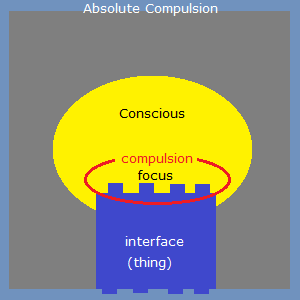
«The compulsive intramuscular sensation» of tic
The disagreeable physical sensation that “appears” in a voluntary muscle, or in a unit of voluntary muscles (§12). The positional existence of this voluntary muscle will be the object of intentionality (Husserl) in the Conscious. This physical sensation is the trigger for the amplification of the “obsession of immobility” in the Conscious. The Conscious is forced to do the tic movement. A tic movement is always a conscious movement and, of course, a voluntary movement.
The sensation of muscle contraction without muscle contraction in a voluntary muscle. This bodily sensation might be falsely similar to very localized muscular fatigue too.
It is called wrongly “premonitory urge”, but as a tic movement is a very conscious voluntary movement which the Conscious absolutely has to do, this disagreeable bodily sensation is not “premonitory” to a tic movement. Also as this sensation is a localized real physical sensation, it is not an “urge”.
When the Conscious is indirectly dominated by the Absolute Compulsion, this physical sensation is the interface of the Conscious.
This physical sensation, which appears locally in voluntary muscles, is not illusion in the Conscious.
The reason why this physical sensation is not an illusion is that the positional existence of any voluntary muscle can easily become an object of the Conscious. In fact, the Conscious takes this muscle as an object, but it seems as if the sensation of the muscle appeared in the Conscious. This physical sensation is nothing other than the conscious existence of a voluntary muscle. It is obsession with the existing sensation of a voluntary muscle. The dominating force of this obsession is absolute.
Immobility of a voluntary muscle (as obsession)
The obsession (intrusive thought) which amplifies itself from the muscular sensation (the compulsive intramuscular sensation of tic). The compulsive movement of tic is the resolution of the compulsive intramuscular sensation of tic, and at the same time the resolution of this ridiculous obsession of the immobility, i.e., “This voluntary muscle can no longer move.” The Conscious is compulsively forced to check the voluntary contractibility of a voluntary muscle. By the eyes of other people around the patient, the voluntary contractibility of a voluntary muscle is observed as the mobility of that part of the body and as a “movement”. Tic disorder is a sort of obsessive-compulsive disorder with the obsession of the immobility, which is indicated positionally by the physical sensation of a voluntary muscle. Therefore, tic disorder and obsessive-compulsive disorder should be treated in the same way.
Absurdity
The purpose of tic disorder and obsessive-compulsive disorder is to repress the traumatic emotion.
The intentionality of the Conscious is directed towards a second object which is not related to the trauma.
The second object is selected at random to interfere with the rational Conscious and to disturb the reason of the Conscious of the patient. The childishness of coprolalia words, the stupid speed of tic movements, etc.
Tic disorder and obsessive-compulsive disorder are the bodily repression of the body part which is associated with the traumatic emotion. In order to repress the libidinal body part, a non-libidinal body part will be randomly selected with rationalization for the object of the Conscious.
« Compulsive intramuscular sensation » of OCD
Disagreeable physical sensation (e.g., skin sensation, etc.) that triggers obsession of the bodily act in obsessive-compulsive disorder. The sensation which is imitation of adrenergic effects in panic disorder. The compulsivity of the obsession amplifies itself in the Conscious.
Compulsivity is an innate function of repression, and the force of compulsivity is equal to the force of repression. The repression function is incurable, therefore pathological compulsivity will be treated by the discovery of the traumatic image and by emotional catharsis.
A traumatic image is a pleasant image, under repression.
KV
Körperliche Verdrängung, bodily repression.
KV is a congenital mechanism of the patient, and the theory of the Kuriki method is the theory of neurosis caused by KV. If the therapeutic method is correct, the patient with tic disorder and obsessive-compulsive disorder will be cured of both diseases at the same time. The healing of a case of tic disorder means the disappearance of the amplification of compulsivity in the compulsive intramuscular sensation of tic, and the healing of obsessive-compulsive disorder means the disappearance of the amplification of compulsivity in the compulsive physical sensation of OCD. If a person who is a little bit Asperger has KV, his KV may be the compulsive intramuscular sensation of tic, or the compulsive physical sensation of OCD, or both. KV in a case of tic disorder is the compulsive intramuscular sensation of tic, and KV in a case of obsessive-compulsive disorder is the compulsive physical sensation of OCD. KV is a mechanism of repression based on congenital predisposition, and the mechanism of KV might start to function at the age of three years. As the cause of obesity, for example, is a congenital predisposition and this predisposition cannot be healed, but diet and exercise can resolve the problem, even though the mechanism of KV is a congenital predisposition and the predisposition cannot be healed, the bodily symptoms of neurosis can disappear after the exteriorization of the object of repression by emotional catharsis. When the Unconscious has no object to hide to the Conscious (libidinal traumatic emotion), it is not necessary to use KV, and KV will cease to function compulsively. Emotional catharsis with the understanding of the mechanism of KV will make the bodily symptoms of neurosis disappear. The Kuriki method is to eliminate the compulsivity from the neurotic KV and to make the KV no compulsive. After the treatment, KV will sometimes manifest itself only for the repression of bodily direct disagreeable sensations (indefinite repressed sensations, such as coldness, fatigue, etc.) without compulsivity and will no longer have the role of the repression of traumatic emotion. People (a little bit Asperger?) who have KV should learn the emotional catharsis with a psychoanalyst.
¤4double_repression
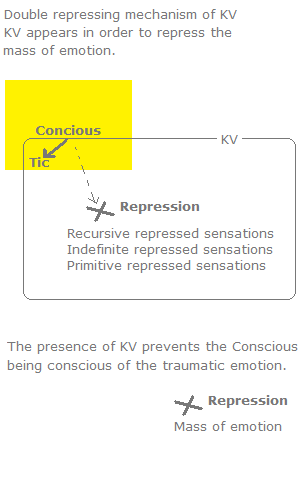
There are three types of bodily sensations, which are repressed by KV.
· Primitive repressed sensations §26
· Indefinite repressed sensations §27
· Recursive repressed sensations §28
The object that is repressed by the presence of KV.
· Mass of emotion
It is not theoretical existence, but really perceptible existence. It will be converted into emotion by emotional catharsis, and quantitatively perceived. The potential energy of disagreeable judgments (judging that something is disagreeable), which have been suspended and frozen without being expressed emotionally, i.e., physically in the Conscious. The potential energy behind the traumatic image will be converted into emotional energy by emotional catharsis. Without trying emotional catharsis, a person who has the predisposition to autistic KV cannot make the distinction between the traumatic image and the ordinary images. If there is an explosion at the time of the trying, it is the traumatic image.
If the patient has understood that the symptom of neurosis is bodily repression, for example, after a week or two, in the morning, an image which may be the traumatic image will come to mind upon awakening.
Insulator, (originally a term of the electricity).
A mass of emotion consists of traumatic images, insulators and potential emotions, which are placed one inside the other, like an onion. The layer of potential emotion is conserved behind the layer of insulator. If a too strong explosion of catharsis has been imprudently done without knowledge of emotional catharsis, the insulator may be perceived during ten minutes as a thing that closes. This closing movement has specific slowness like the movement of a mollusk. In the mass of emotion, there is the insulator under the traumatic image. It contains hermetically the potential emotion. This word doesn’t mean the isolation between the society and an individual.

¤5closing
Repression in double structure
1. The upper layer (KV)
KV, which is congenital, is a mechanism of repression on the physical disagreeable sensations, which are healthy and normal, by the combination of the disagreeable physical sensation (the compulsive intramuscular sensation of tic, the compulsive physical sensation of OCD) and its solution by a specific bodily movement (or an act). Intrinsically, KV in itself is not neurotic. On the existence of the lower layer (mass of emotion), KV can take compulsivity (absolute necessity) and become the upper layer of neurosis. The healed state of the neurosis means that the compulsiveness has disappeared from the KV. ¤6kv_tic_ocd
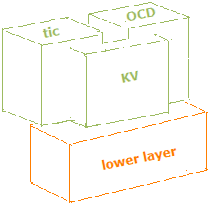
2. The lower layer (mass of emotion)
As the disagreeable libidinal judgment remains unexpressed, a large amount of disagreeable libidinal emotion remains repressed. It is the restless activity of the upper layer that is the persistent object on the foreground of the Conscious, and consequently, the lower layer will be repressed. The upper layer in operation will be absolutely necessary for the repression of the lower layer. The upper layer will be dominated by the Absolute Compulsion and will make the symptom of neurosis. The symptom of neurosis is a repression mechanism. Therefore, the treatment of the lower layer (explosion of emotional catharsis) will eliminate the compulsivity of the upper layer. While the patient always has his KV, after the treatment of the lower layer, his KV will lose compulsivity; i.e., his KV will lose the absolute necessity of being the upper layer of neurosis.
Absolute Compulsion
While the word “compulsion” means in general the invading thought of OCD, in the Kuriki method, Absolute Compulsion is the structure of neurosis, which consists of the stubborn sequence of neurotic physical sensation, amplification of compulsion, and neurotic bodily action.
Psychic motor unit
In the structure of tic disorder, the unit of muscle does not mean anatomical unit of muscle, but a group of voluntary muscles that has been physically known with a movement. Thus, for example, while the pronunciation of a word of coprolalia “xxxx” is anatomically complex, it is mentally a simple muscular movement. §12
(b) Freudian terms which are defined very differently in the Kuriki method.
The psychoanalytic terms make sense only in descriptions of treatments for the physical symptoms of Neurosis. Freud’s simple imaginary theory has not changed from the start. In 1923, he adopted easier descriptive representation. The problem with the general public reading Freud’s books is that many people do not know the physical symptoms of neurotic patients. They do not understand that psychoanalysis is only the description of a way to heal the physical symptoms of neurosis. Therefore, they confuse their healthy mind with neurotic mind, psychology with psychoanalysis, feelings actually felt with purely theoretical elements. They do not understand that the words “healthy Super-ego”, “healthy Id”, “healthy Ego”, “healthy Unconscious”, etc., do not make sense and such mental zones do not exist. Often healthy general readers try to understand them as elements in the Conscious of healthy mind, psychologically applying them to perceptible elements in their Conscious, and that will cause a big misunderstanding. For example, unresolved Oedipus complex is descriptive representation of the incomplete symbolic triangle in the Unconscious for treatment of neurosis, and it is not question of the triangular relationship with the real mother and the real father in the Conscious of a healthy person.
The Unconscious, the Ego, the Super-ego, the Id, Libido, etc., are theoretical elements, which are totally imperceptible. These terms are speculative and descriptive representations concerning exclusively the physical symptoms of neurosis; a way to explain the treatment.
The Super-ego
The symptoms of tic disorder can appear at the age of three, and the development of Freudian Super-ego begins at the age of five, therefore, whether the patient is an adult or a child, Freudian Super-ego is not an issue in the treatment of tic disorder. Also the Ego and the Id in the Unconscious are excluded from the main elements of the structure of tic disorder and obsessive compulsive disorder.
Repression
As repression is a function that blocks objects of the Conscious, bodily sensations can be repressed too. In the Kuriki method, there is no structure such as the Ego does the repression on the Id.
Rationalization (§13 – §19)
In the Kuriki method, rationalization is the pathological function that selects arbitrarily, regardless of the content of the trauma, one or more of the possible bodily symptoms (i.e., objects of the Conscious). The word “arbitrarily” means; randomly, as throwing a dice. Conditionally, like “I do it for verification.”, rationalization always requires a plausible false motive.
(1)
The rationalization function of KV selects arbitrarily one or more categories of neurotic upper layer (neurotic KV); tic disorder, obsessive compulsive disorder, panic disorder, etc.
(2)
The rationalization function of tic disorder selects arbitrarily a combination of «voluntary movement» – «positional presence of a voluntary muscle and the obsession of immobility» – «false motive».
The rationalization function of obsessive-compulsive disorder selects arbitrarily a combination of «bodily action» – «physical sensation of anxiety» – «false motive».
The rationalization function of panic disorder selects a trigger that justifies «fear of fear» of adrenergic physical reactions to fear, with «impossible escape».
Catharsis
In the Kuriki method, explosions of emotional catharsis as a way of treatment of neurosis for adults. The discovery of the trauma and the verbalization will not suffice as abreaction.
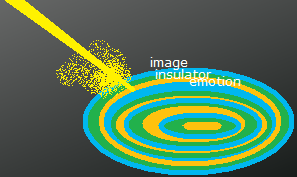
¤7catharsis
Libido
A term for the description of the treatment of neurosis. The energetic element in the structure of neurosis. The term “libido” has no meaning outside the treatment of neurosis.
Trauma
For a child who has autism spectrum disorder, his or her infantile trauma is not necessarily a dramatic event to the eyes of adults.
An ordinary event can be traumatic. For example, cutaneous contact with an adult person can be extremely disagreeable, etc. That is, a traumatic image is the presentation of a traumatic event, but the disagreeable object can be a physical sensation of the patient.
The disagreeable judgment is not emotionally expressed and the frozen state is conserved. This conservating operation is the symptom.
(c) Others
Vocal tic
As a movement of vocal tic is a movement to resolve the compulsive intramuscular sensation of tic in the vocal muscle, vocal tic is a subset of motor tic. The compulsion to do a movement of vocal tic is placed in the foreground of the Conscious with a shock of noise as an object, obstructing the flow of thought towards the traumatic image.
Since various types of tic movements and various types of OCD acts are randomly selected by the Unconscious, the classification of the types of movements and acts is useless. Moreover the classification will prevent the understanding about the structure of these diseases. So the Kuriki method does not classify the types of the tic movements and the OCD acts.
Coprolalia
Coprolalia is a type of tic disorder. The element of infantilism in the selection of the word by rationalization is remarkable.
disagreeable
When a disagreeable object has been repressed by the Unconscious, in fact, this object is not disagreeable for the Conscious. So a disagreeable object means that this object would be disagreeable, if it had not been repressed.
When something is disagreeable, “disagreeableness” is a physical sensation, and that physical sensation is disagreeable. When this physical sensation is under repressing operation, the “disagreeableness” of the event-image is repressed.
The repression is not the repression of a disagreeable event: The repression is the repression of disagreeable emotion.
Physical sensation and bodily sensation
In the Kuriki method, the antonym of the mental sensation (sentiment, etc.) is the physical sensation (itching, etc.). The bodily sensation, such as the bodily sensation of the right arm, the bodily sensation of the left arm, etc., is the physical sensation that may have schematic notion of locality and activity as a body part.

 Just as traffic rules have no meaning in the desert, the terms of neurosis treatment have no meaning in a healthy mind without neurosis. Proving the existence of psychoanalytic elements is equivalent to proving that an electric current is a current of water. The electric current is a current of water: it is not a hypothesis, but a descriptive expression. Similarly, the existence of the Unconscious is not a hypothesis, but a descriptive expression to explain how to treat the physical symptoms of neurosis.
Just as traffic rules have no meaning in the desert, the terms of neurosis treatment have no meaning in a healthy mind without neurosis. Proving the existence of psychoanalytic elements is equivalent to proving that an electric current is a current of water. The electric current is a current of water: it is not a hypothesis, but a descriptive expression. Similarly, the existence of the Unconscious is not a hypothesis, but a descriptive expression to explain how to treat the physical symptoms of neurosis.